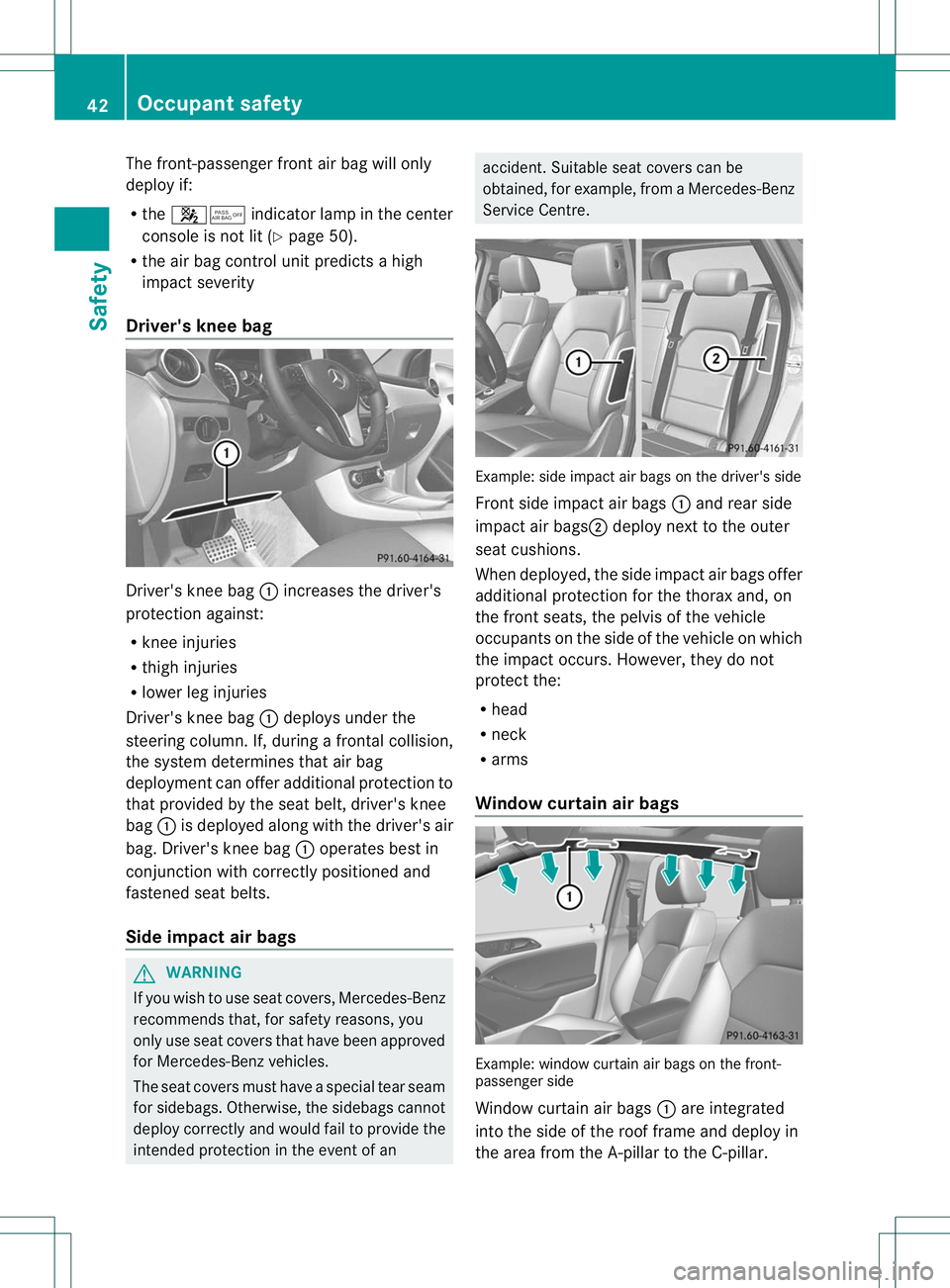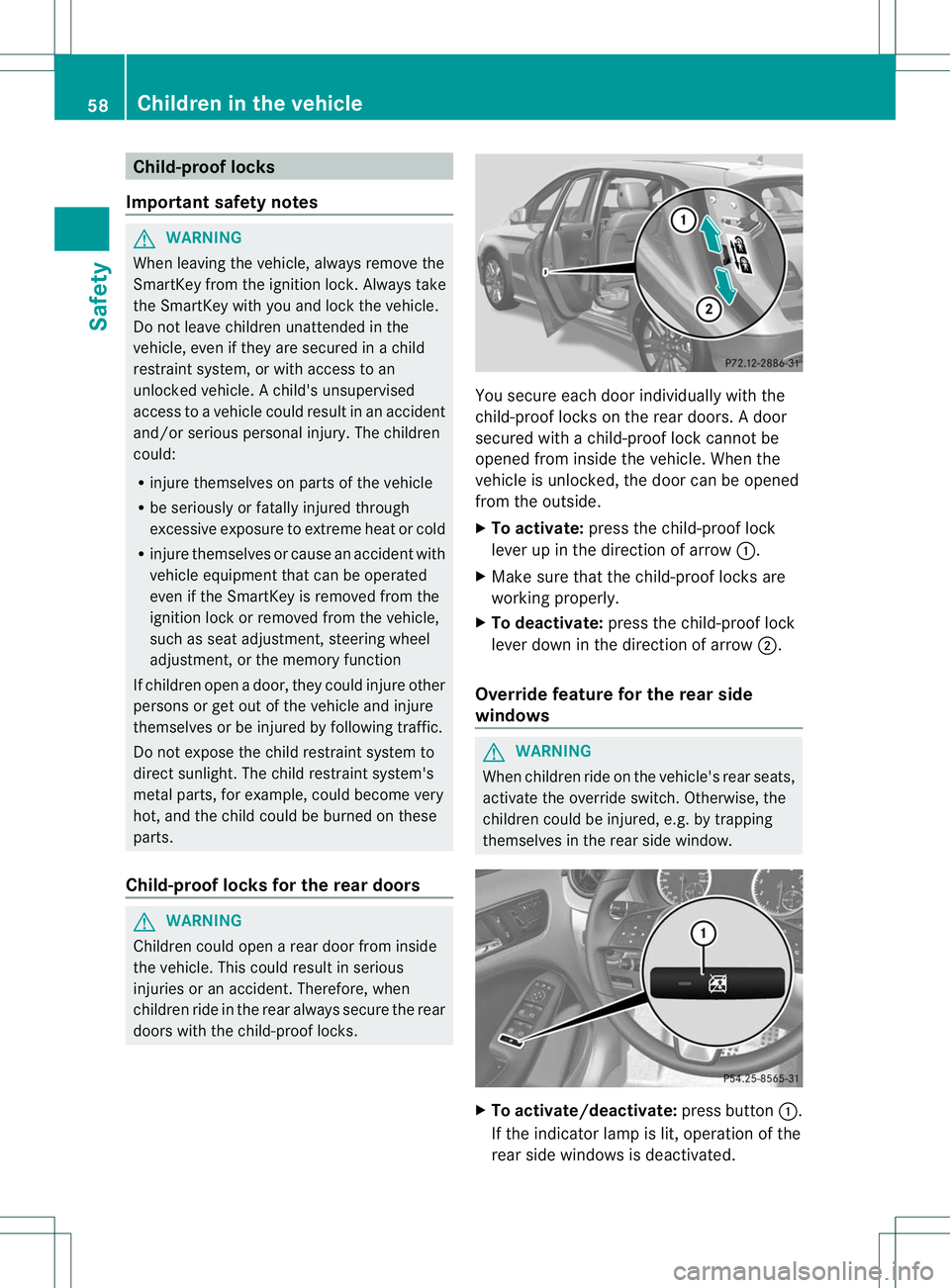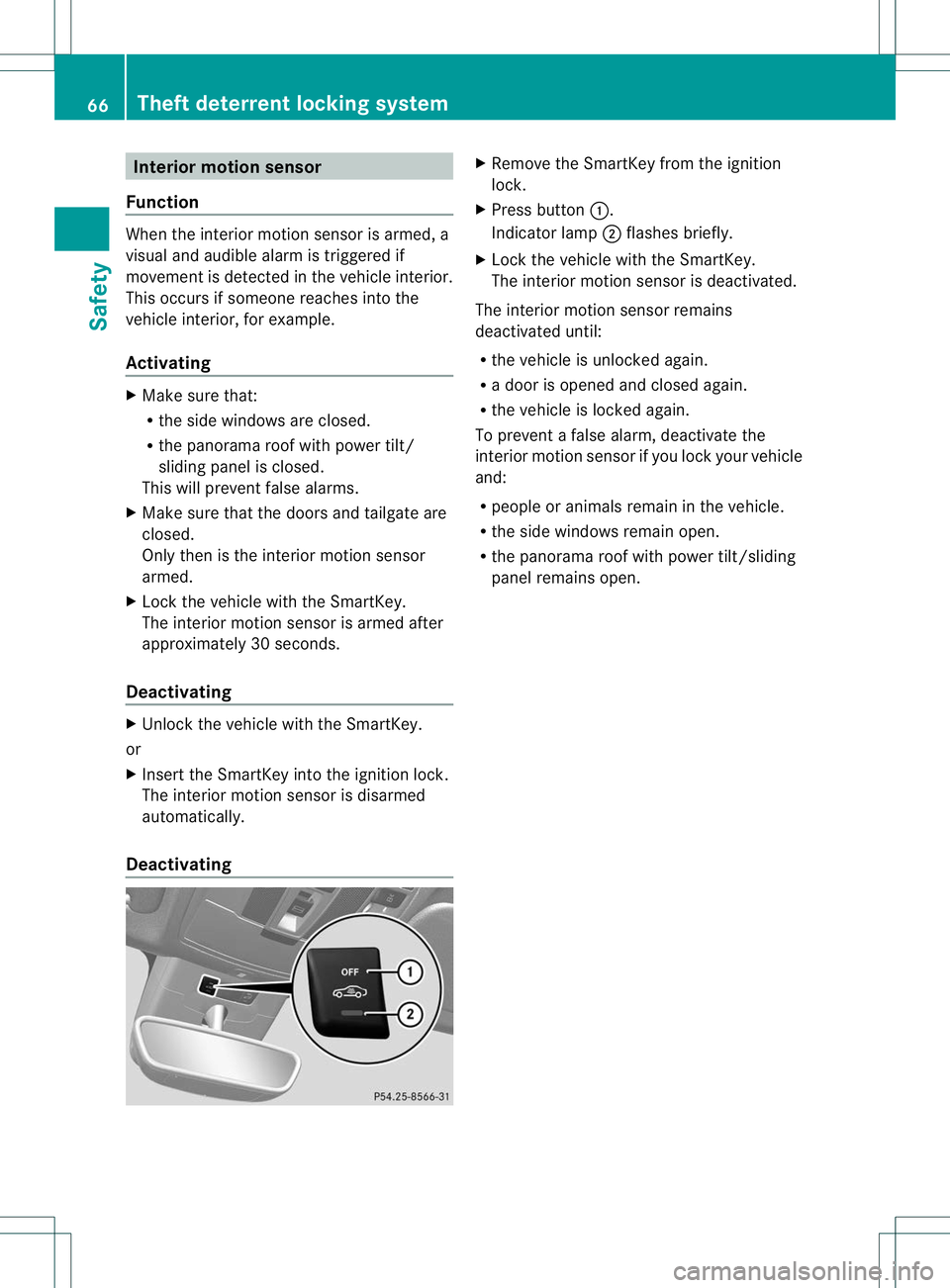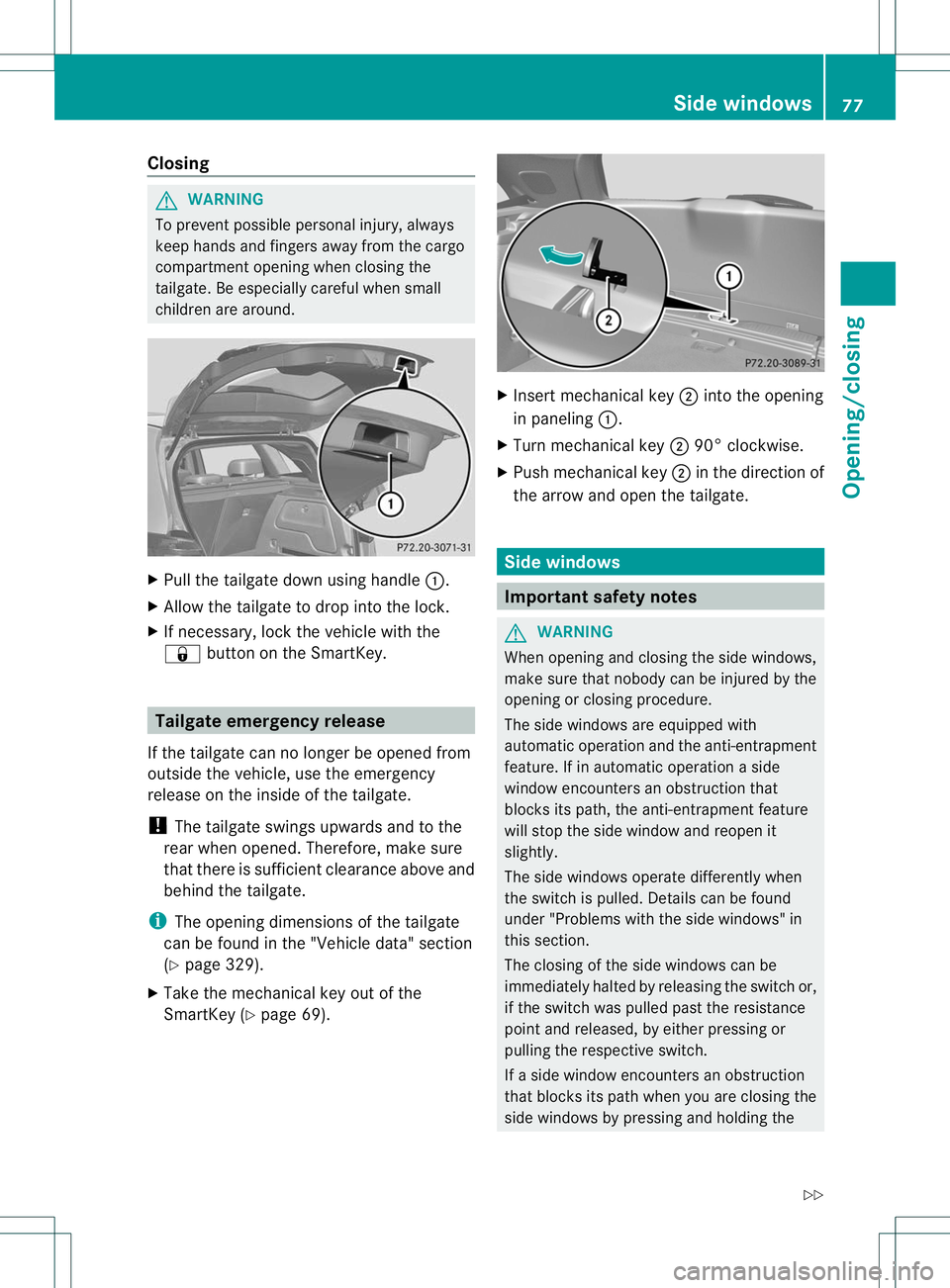2013 MERCEDES-BENZ B-CLASS SPORTS window
[x] Cancel search: windowPage 45 of 336

The front-passenger fronta
ir bag will only
deploy if:
R the 45 indicator lamp in the center
console is not lit (Y page 50).
R the air bag control unit predicts a high
impac tseverity
Driver's knee bag Driver's knee bag
:increases the driver's
protection against:
R knee injuries
R thigh injuries
R lower leg injuries
Driver's knee bag :deploys under the
steering column. If, during a frontal collision,
the system determines that air bag
deployment can offer additional protection to
that provided by the seat belt, driver's knee
bag :is deployed along with the driver's air
bag. Driver's knee bag :operates best in
conjunction with correctly positioned and
fastened seat belts.
Side impact air bags G
WARNING
If you wish to use seat covers, Mercedes-Benz
recommends that, for safety reasons, you
only use seat covers that have been approved
for Mercedes-Benz vehicles.
The seat covers must have a special tear seam
for sidebags. Otherwise, the sidebags cannot
deploy correctly and would fail to provide the
intended protection in the event of an accident. Suitable seat covers can be
obtained, for example, from a Mercedes-Benz
Service Centre.
Example: side impact air bags on the driver's side
Fron
tside impac tair bags :and rear side
impac tair bags ;deploy nex tto the outer
seat cushions.
When deployed, the side impact air bags offer
additional protection for the thorax and, on
the front seats, the pelvis of the vehicle
occupants on the side of the vehicle on which
the impact occurs. However, they do not
protect the:
R head
R neck
R arms
Window curtain air bags Example: window curtain air bags on the front-
passenger side
Window curtain air bags
:are integrated
into the side of the roof frame and deploy in
the area from the A-pillar to the C-pillar. 42
Occupant safetySafety
Page 46 of 336

When deployed, window curtain air bags
:
increase protection for the heads of vehicle
occupants on the side of the vehicle on which
the impact occurs .However, they do not
protect the:
R chest
R arms
They are deployed:
R on the side on which an impact occurs
R at the start of an accident with a high rate
of lateral vehicle deceleration or
acceleration, e.g. in aside impact
R regardless of whether the front-passenger
seat is occupied
R independently of the use of the seat belt
R independently of the front air bags
Window curtain air bags :will not deploy in
impacts with deceleration rates which do not
exceed the system's prese tdeployment
thresholds for vehicle deceleration or
acceleration. You will then be protected by
the fastened seat belt. Seat belts
Important safety notes G
WARNING
Always fasten your seat belt before driving off.
Always make sure all of your passengers are
properly restrained. You and your passengers
should always wear seat belts.
Failure to wear and properly fasten and
position your seat belt greatly increases your
risk of injuries and their likely severity in an
accident.
If you are ever in an accident, your injuries can
be considerably more severe without your
seat belt properly buckled. Without your seat
belt buckled, you are much more likely to hit
the interior of the vehicle or be ejected from
it. You can be seriously injured or killed.
In the same crash, the possibility of injury or
death is lessened if you are properly wearing your seat belt. The air bags can only protect
as intended if the occupants are properly
wearing their seat belts.
G
WARNING
Never ride in a moving vehicle with the seat
backrest in an excessively reclined position as
this can be dangerous. You could slide under
the seat belt in a collision. If you slide under
it, the seat belt would apply force at the
abdomen or neck .That could cause serious
or even fatal injuries. The seat backrest and
seat belt provide the best restraint when the
wearer is in a position that is as upright as
possible and the seat belt is properly
positioned on the body. G
WARNING
Never let more people ride in the vehicle than
there are seat belts available. Make sure
everyone riding in the vehicle is correctly
restrained with a separate seat belt. Never
use a seat belt for more than one person at a
time. G
WARNING
Damaged seat belts or seat belts that have
been subjected to stress in an accident must
be replaced and their anchoring points must
also be checked.
Only use seat belts which have been approved
by Mercedes-Benz.
Do not make any modifications to the seat
belts. This can lead to unintended activation
of the ETDs or to their failure to activate when
necessary.
Do not bleach or dye seat belts as this may
severely weaken them. In a crash they may
not be able to provide adequate protection.
Have all work carried out only by qualified
technicians. Contact an authorized
Mercedes-Benz Center.
The use of infant or child restraints is required
by law in all 50 states, the Districtof Occupant safety
43Safety Z
Page 47 of 336

Columbia, the U.S. territories and all
Canadian provinces.
Even where this is nott
he case, all vehicle
occupants should have their seat belts
fastened when the vehicle is in motion.
i See "Children in the vehicle"
(Y page 47) for further information on
infants and children traveling in the vehicle
as well as on child restraint systems.
Proper use of the seat belts G
WARNING
USE SEAT BELTS PROPERLY
R Seat belts can only work when used
properly. Never wear seat belts in any other
way than as described in this section, as
that could result in serious injuries in the
event of an accident.
R Each occupant should wear their seat belt
at all times, because seat belts help reduce
the likelihood of and potential severity of
injuries in accidents, including rollovers.
The integrated restraint system includes
SRS (driver front air bag, driver's side knee
bag, front-passenger front air bag, side
impact air bags, window curtain air bags for
the side windows), Emergency Tensioning
Devices, seat belt force limiters, and front
seat knee bolsters.
The system is designed to enhance the
protection offered to properly belted
occupants in certain frontal (front air bags,
driver's side knee bag and ETDs) and side
(side impact air bags, window curtain air
bags, and ETDs) impacts which exceed
preset deployment thresholds and in
certain rollovers (window curtain air bags
and ETDs).
R Never wear the shoulder belt under your
arm, across your neck or off your shoulder.
In a frontal crash, your body would move
too far forward. That would increase the
chance of head and neck injuries. The seat
belt would also apply too much force to the
ribs or abdomen, which could severely injure internal organs such as your liver or
spleen.
Adjust the seat belt so that the shoulder
section is located as close as possible to
the middle of the shoulder. It should not
touch the neck.N
ever pass the shoulder
portion of the seat belt under your arm. For
this purpose, you can adjust the height of
the seat belt outlet.
R Position the lap belt as low as possible on
your hips and not across the abdomen. If
the lap belt is positioned across your
abdomen, it could cause serious injuries in
a crash.
R Never wear seat belts over rigid or
breakable objects in or on your clothing,
such as eyeglasses, pens, keys etc., as
these might cause injuries.
R Make sure the seat belt is always fitted
snugly. Take special care of this when
wearing loose clothing.
R Never use a seat belt for more than one
person at a time. Do not fasten a seat belt
around a person and another person or
other objects at the same time.
R Seat belts should not be worn twisted. In a
crash, you would not have the full width of
the seat belt to distribut eimpact forces.
The twisted seat belt against yourb ody
could cause injuries.
R Pregnant women should also always use a
lap-shoulder belt. The lap belt portion
should be positioned as low as possible on
the hips to avoid any possible pressure on
the abdomen.
R Place the seat backrest in a position that is
as upright as possible.
R Check your seat belt during travel to make
sure it is properly positioned.
R Never place your feet on the instrument
panel, dashboard, or on the seat. Always
keep both feet on the floor in front of the
seat.
R When using a seat belt to secure infant
restraints, toddler restraints, or children in 44
Occupant safetySafety
Page 54 of 336

cannot perform its intended protective
function in the event of an accident, and could
lead to injuries.
G
WARNING
Do not place electronic devices on the front-
passenger seat, e.g.:
R laptops, whe nswitched on
R mobile phones
R cards with transponders, e.g .ski passes or
access cards
Signals from electronic equipment can cause
interference in the sensor system of the air
bag deactivatio nsystem. This can lead to a
system malfunction .This may cause the
4 PASSENGER AIR BAG OFF indicator
lamp to light up even if no child seat with a
transponder for an air bag deactivation
system is installed. The front-passenger air
bag would not then deploy during an accident.
It is also possible that the 6SRS warning
lamp lights up and/or the 4PASSENGER
AIR BAG OFF indicator lamp does not light up
briefly when you turn the key in the ignition
lock to position 2. The sensor system of the air bag deactivation
system on the front-passenger seat detects
whether a special Mercedes-Ben
zchild seat
has been installed there. To support
detection by the sensor system, the
Mercedes-Benzc hild seat is equipped with
transponders for the air bag deactivation
system. In this case, the 45:indicator lamp lights up. The front-passenger
air bag is deactivated.
i
If the front-passenger air bag is
deactivated by the air bag deactivation
system, the following remain enabled on
the front-passenger side:
R the side impact air bag
R the window curtain air bag
R the Emergency Tensioning Device
LATCH-type (ISOFIX) child seat anchors
in the rear G
WARNING
Children that are too large for a child restraint
must travel in seats using normal seat belts.
Position the shoulder belt across the chest
and shoulder, not face or neck.
Ab ooster seat may be necessary to achieve
proper seat belt positioning for children over
41 lb (18 kg) until they reach a height where
a lap/shoulder belt fits properly without a
booster.
Install the child restraint system in
accordance with the manufacturer's
instructions.
Attach the child restraint system to both
securing rings.
An incorrectly installed child restraint system
could come loose during an accident and
seriously or even fatally injure the child.
Child restraint systems or child seat securing
rings that are malfunctioning or damaged as
the result of a collision must be replaced.
! When installing the child restraint system,
make sure that the seat belt for the middle
seat does not get trapped. The seat belt
could otherwise be damaged. Children in the vehicle
51Safety Z
Page 61 of 336

Child-proof locks
Important safety notes G
WARNING
When leaving the vehicle, always remove the
SmartKey from the ignition lock. Always take
the SmartKey with you and loc kthe vehicle.
Do not leave children unattended in the
vehicle, even if they are secured in a child
restraint system, or with access to an
unlocked vehicle. Achild's unsupervised
access to a vehicle could result in an accident
and/or serious personal injury. The children
could:
R injure themselves on parts of the vehicle
R be seriously or fatally injured through
excessive exposure to extreme heat or cold
R injure themselves or cause an accident with
vehicle equipment that can be operated
even if the SmartKey is removed from the
ignition lock or removed from the vehicle,
such as seat adjustment, steering wheel
adjustment, or the memory function
If children open a door, they could injure other
persons or get out of the vehicle and injure
themselves or be injured by following traffic.
Do not expose the child restraint system to
direct sunlight. The child restraint system's
metal parts, for example, could become very
hot, and the child could be burned on these
parts.
Child-proof locks for the rear doors G
WARNING
Children could open a rear door from inside
the vehicle. This could result in serious
injuries or an accident. Therefore, when
children ride in the rear always secure the rear
doors with the child-proof locks. You secure each door individually with the
child-proof locks on the rear doors.
Adoor
secured with a child-proof lock cannot be
opened from inside the vehicle. When the
vehicle is unlocked, the door can be opened
from the outside.
X To activate: press the child-proof lock
lever up in the direction of arrow :.
X Make sure that the child-proof locks are
working properly.
X To deactivate: press the child-proof lock
lever down in the direction of arrow ;.
Override feature for the rear side
windows G
WARNING
When children ride on the vehicle's rear seats,
activate the override switch. Otherwise, the
children could be injured, e.g. by trapping
themselves in the rear side window. X
To activate/deactivate: press button:.
If the indicator lamp is lit, operation of the
rear side windows is deactivated. 58
Children in the vehicleSafety
Page 69 of 336

Interior motion sensor
Function When the interio
rmotion sensor is armed, a
visual and audible alarm is triggered if
movemen tis detected in the vehicle interior.
This occurs if someone reaches into the
vehicle interior, for example.
Activating X
Make sure that:
R
the side windows are closed.
R the panorama roof with power tilt/
sliding panel is closed.
This will prevent false alarms.
X Make sure that the doors and tailgate are
closed.
Only then is the interior motion sensor
armed.
X Lock the vehicle with the SmartKey.
The interior motion sensor is armed after
approximately 30 seconds.
Deactivating X
Unlock the vehicle with the SmartKey.
or
X Insert the SmartKey into the ignition lock.
The interior motion sensor is disarmed
automatically.
Deactivating X
Remove the SmartKey from the ignition
lock.
X Press button :.
Indicator lamp ;flashes briefly.
X Lock the vehicle with the SmartKey.
The interior motion sensor is deactivated.
The interior motion sensor remains
deactivated until:
R the vehicle is unlocked again.
R a door is opened and closed again.
R the vehicle is locked again.
To prevent a false alarm, deactivate the
interior motion sensor if you lock your vehicle
and:
R people or animals remain in the vehicle.
R the side windows remain open.
R the panorama roof with power tilt/sliding
panel remains open. 66
Theft deterrent locking systemSafety
Page 70 of 336

Useful information
..............................68
SmartKey ............................................. 68
Doors .................................................... 73
Cargo compartment ............................76
Side windows ...................................... 77
Sliding sunroof .................................... 80 67Opening/closing
Page 80 of 336

Closing
G
WARNING
To preventp ossible personal injury, always
keep hands and fingers away from the cargo
compartment opening when closing the
tailgate. Be especially careful when small
children are around. X
Pull the tailgate down using handle :.
X Allow the tailgate to drop into the lock.
X If necessary, lock the vehicle with the
& button on the SmartKey. Tailgate emergency release
If the tailgate can no longer be opened from
outside the vehicle, use the emergency
release on the inside of the tailgate.
! The tailgate swings upwards and to the
rear when opened. Therefore, make sure
that there is sufficient clearance above and
behind the tailgate.
i The opening dimensions of the tailgate
can be found in the "Vehicle data" section
(Y page 329).
X Take the mechanical key out of the
SmartKey (Y page 69). X
Insert mechanical key ;into the opening
in paneling :.
X Turn mechanical key ;90° clockwise.
X Push mechanical key ;in the direction of
the arrow and open the tailgate. Side windows
Important safety notes
G
WARNING
When opening and closing the side windows,
make sure that nobody can be injured by the
opening or closing procedure.
The side windows are equipped with
automatic operation and the anti-entrapment
feature. If in automatic operation a side
window encounters an obstruction that
blocks its path, the anti-entrapment feature
will stop the side window and reopen it
slightly.
The side windows operate differently when
the switch is pulled. Details can be found
under "Problems with the side windows" in
this section.
The closing of the side windows can be
immediately halted by releasing the switch or,
if the switch was pulled past the resistance
point and released, by either pressing or
pulling the respective switch.
If a side window encounters an obstruction
that blocks its path when you are closing the
side windows by pressing and holding the Side windows
77Opening/closing
Z